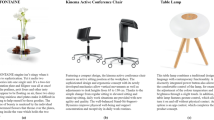Abstract
The design symposium ‘creative connections discusses the designers’ tools in the conceptual phase. Over the past few decades, many considerations, which hitherto occured before or after conceptualizing have become an integrated part of concept development. Examples are studies of users and contexts, and expressive new materials. Also, design tools are becoming increasingly, almost exclusively, computer-based. But current computer tools lack fluency, directness, and bodily involvement of the traditional paper tools, properties which are essential in the creative activities of conceptualizing, The symposium, and its four attached bazaar papers, deal with new tools that are being developed, and old tools that are evolving, to help designers at coping with this complexity of factors.







Similar content being viewed by others
References
Sanders EB-N, Dandavate U (1999) Design for experiencing: new tools. In: Overbeeke CJ, Hekkert P (eds) Proc First Int Conf Des Emotion, TU Delft
Gaver W, Dunne T, Pacenti E (1999) Cultural probes. ACM Interact 6(1):21–29
Sleeswijk Visser F, Visser V (2005) Re-using users: co-create and co-evaluate (this issue)
Sleeswijk Visser F, van der Lugt R, Stappers PJ (2004) The personal cardset— a designer-centred tool for sharing insights from user studies. Proc Second Int Conf Appliance Design, Bristol, pp 157–158
Keller AI, Stappers PJ (2001) Presence for design: conveying atmosphere through video. Cyber Psychol Behav 4 (2):215–224
van der Lelie C (2005) The value of storyboards in the product design process (this issue)
Saakes D (2005) Material light: exploring expressive materials (this issue)
Keller I, Hoeben A, van der Helm A (2005) Cabinet: Merging designers' digital and physical collections of visual materials (this issue)
Stappers PJ, Hennessey JM (1999) Towards electronic napkins and beermats: computer support for visual ideation skills. In: Paton RC, Neilson E (eds) Vis Representations and Interpretations. Proc VRI’98, Liverpool, September 22–24, Springer, Berlin Heidelberg New York, pp 220–225
Stappers PJ, Gaver WW, Overbeeke CJ (2004) Beyond the limits of real-time realism: Uses, necessity and theoretical foundation of non-realistic virtual reality. In: Hettinger LJ, Haas MW (eds) Psychological issues design use of adaptive, virtual interfaces, Erlbaum
Saakes DP, Stappers PJ (2002) Designing architectural walkthroughs: from simulations to presentations by visualising narrative transitions. Inter J Design Comput 4
Hoeben A, Stappers PJ (2005) Taking clues from the world outside: navigating interactive panoramas (this issue)
Keller AI, Stappers PJ, Hoeben A (2000) TRI: inspiration support for a design studio environment. Inter J Design Computing 3:1–17
Author information
Authors and Affiliations
Corresponding author
Additional information
This paper is part of the 3AD design colloquium creative connections.
Rights and permissions
About this article
Cite this article
Stappers, P.J. Creative connections: user, designer, context, and tools. Pers Ubiquit Comput 10, 95–100 (2006). https://doi.org/10.1007/s00779-005-0024-9
Received:
Accepted:
Published:
Issue Date:
DOI: https://doi.org/10.1007/s00779-005-0024-9




